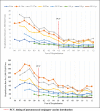Australian Aboriginal children have higher hospitalization rates for otitis media but lower surgical procedures than non-Aboriginal children: A record linkage population-based cohort study
- PMID: 31013285
- PMCID: PMC6478284
- DOI: 10.1371/journal.pone.0215483
Australian Aboriginal children have higher hospitalization rates for otitis media but lower surgical procedures than non-Aboriginal children: A record linkage population-based cohort study
Abstract
Introduction: Otitis media (OM) is one of the most common infectious diseases affecting children globally and the most common reason for antibiotic prescription and paediatric surgery. Australian Aboriginal children have higher rates of OM than non-Aboriginal children; however, there are no data comparing OM hospitalization rates between them at the population level. We report temporal trends for OM hospitalizations and in-hospital tympanostomy tube insertion (TTI) in a cohort of 469,589 Western Australian children born between 1996 and 2012.
Materials and methods: We used the International Classification of Diseases codes version 10 to identify hospitalizations for OM or TTI recorded as a surgical procedure. Using age-specific population denominators, we calculated hospitalization rates per 1,000 child-years by age, year and level of socio-economic deprivation.
Results: There were 534,674 hospitalizations among 221,588 children hospitalized at least once before age 15 years. Aboriginal children had higher hospitalization rates for OM than non-Aboriginal children (23.3/1,000 [95% Confidence Interval (CI) 22.8,24.0] vs 2.4/1,000 [95% CI 2.3,2.4] child-years) with no change in disparity over time. Conversely non-Aboriginal children had higher rates of TTI than Aboriginal children (13.5 [95% CI 13.2,13.8] vs 10.1 [95% CI 8.9,11.4]). Children from lower socio-economic backgrounds had higher OM hospitalization rates than those from higher socio-economic backgrounds, although for Aboriginal children hospitalization rates were not statistically different across all levels of socio-economic disadvantage. Hospitalizations for TTI among non-Aboriginal children were more common among those from higher socio-economic backgrounds. This was also true for Aboriginal children; however, the difference was not statistically significant. There was a decline in OM hospitalization rates between 1998 and 2005 and remained stable thereafter.
Conclusion: Aboriginal children and children from lower socio-economic backgrounds were over-represented with OM-related hospitalizations but had fewer TTIs. Despite a decrease in OM and TTI hospitalization rates during the first half of the study for all groups, the disparity between Aboriginal and non-Aboriginal children and between those of differing socioeconomic deprivation remained.
Conflict of interest statement
The authors have declared that no competing interests exist.
Figures




Similar articles
-
Ethnic differences in acute hospitalisations for otitis media and elective hospitalisations for ventilation tubes in New Zealand children aged 0-14 years.N Z Med J. 2015 Jun 12;128(1416):10-20. N Z Med J. 2015. PMID: 26117671
-
Temporal Trends in and Patient Characteristics Associated with Surgery for Otitis Media.Laryngoscope. 2025 May;135(5):1821-1829. doi: 10.1002/lary.31916. Epub 2024 Dec 5. Laryngoscope. 2025. PMID: 39633242 Free PMC article.
-
The Impact of Pneumococcal Vaccination on Bacterial and Viral Pneumonia in Western Australian Children: Record Linkage Cohort Study of 469589 Births, 1996-2012.Clin Infect Dis. 2018 Mar 19;66(7):1075-1085. doi: 10.1093/cid/cix923. Clin Infect Dis. 2018. PMID: 29069315
-
A review of the burden of disease due to otitis media in the Asia-Pacific.Int J Pediatr Otorhinolaryngol. 2012 May;76(5):623-35. doi: 10.1016/j.ijporl.2012.02.031. Epub 2012 Mar 8. Int J Pediatr Otorhinolaryngol. 2012. PMID: 22404948 Review.
-
The burden of otitis media.Vaccine. 2000 Dec 8;19 Suppl 1:S2-8. doi: 10.1016/s0264-410x(00)00271-1. Vaccine. 2000. PMID: 11163456 Review.
Cited by
-
Children with Secondary Care Episodes for Otitis Media Have Poor Literacy and Numeracy Outcomes: A Data Linkage Study.Int J Environ Res Public Health. 2021 Oct 15;18(20):10822. doi: 10.3390/ijerph182010822. Int J Environ Res Public Health. 2021. PMID: 34682568 Free PMC article.
-
A five year descriptive analysis of potentially preventable hospitalisations for Ear, Nose, and Throat conditions in regional Victoria, Australia, from 2015 to 2020.BMC Public Health. 2023 Aug 12;23(1):1536. doi: 10.1186/s12889-023-16448-3. BMC Public Health. 2023. PMID: 37568092 Free PMC article.
-
Association Between Social Disadvantage and Otitis Media Treatment in US Children With Commercial Insurance.JAMA Otolaryngol Head Neck Surg. 2022 Nov 10;149(1):7-14. doi: 10.1001/jamaoto.2022.3560. Online ahead of print. JAMA Otolaryngol Head Neck Surg. 2022. PMID: 36355356 Free PMC article.
References
-
- Feigin RD. Feigin & Cherry's textbook of pediatric infectious diseases 6th ed. Philadelphia, PA: Saunders/Elsevier; 2009.
-
- Teele DW, Klein JO, Rosner B. Epidemiology of otitis media during the first seven years of life in children in greater Boston: a prospective, cohort study. J Infect Dis. 1989;160(1):83–94. . - PubMed
-
- Finkelstein JA, Metlay JP, Davis RL, Rifas-Shiman SL, Dowell SF, Platt R. Antimicrobial use in defined populations of infants and young children. Arch Pediatr Adolesc Med. 2000;154(4):395–400. . - PubMed
Publication types
MeSH terms
Substances
LinkOut - more resources
Full Text Sources
Medical

